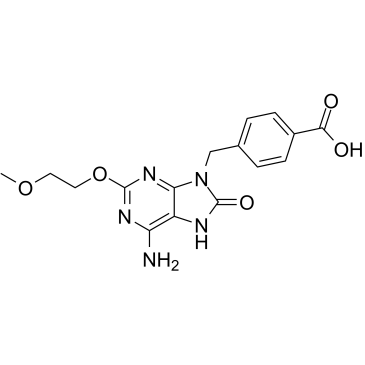| Cas No.: | 1062444-54-5 |
| Synonyms: | TLR7 agonist T7 |
| SMILES: | O=C(C1C=CC(CN2C3C(=C(N=C(N=3)OCCOC)N)NC2=O)=CC=1)O |
| Formula: | C16H17N5O5 |
| M.Wt: | 359.33 |
| Purity: | >98% |
| Sotrage: | 2 years -20°C Powder, 2 weeks 4°C in DMSO, 6 months -80°C in DMSO |
| Publication: | [1]. Battistella C, et al. Delivery of Immunotherapeutic Nanoparticles to Tumors via Enzyme-Directed Assembly. Adv Healthc Mater. 2019 Dec;8(23):e1901105. [2]. Shinchi H, et al. Enhancement of the Immunostimulatory Activity of a TLR7 Ligand by Conjugation to Polysaccharides. Bioconjug Chem. 2015 Aug 19;26(8):1713-23. |
| Description: | 1V209 (TLR7 agonist T7) is a Toll-like receptor 7 (TLR7) agonist and has anti-tumor effects. 1V209 can be conjugated with various polysaccharides to improve its water solubility, and enhance its efficacy, and maintain low toxicity[1][2]. |
| Target: | TLR7 |
| In Vivo: | The intravenous (IV) administration of the formulation to mice bearing 4T1 breast cancer tumors results in nanoparticle accumulation in tumors, reduction in primary tumor growth, and inhibition of lung metastases, as compared to saline-treated animals. Mice administered 1V209 experience significantly increases plasma levels of proinflammatory cytokines IL-6, IP-10, and MCP-1 at 2 h following IV administration[1]. |
| In Vitro: | 1V209 (0.1-10 μM) treatment significantly stimulates TNFα production in RAW246.7 cells[1]. 1V209 (18 hours) treatment increases IL-6 production comparain bone marrow derived dendritic cells[1]. |
| References: | [1]. Battistella C, et al. Delivery of Immunotherapeutic Nanoparticles to Tumors via Enzyme-Directed Assembly. Adv Healthc Mater. 2019 Dec;8(23):e1901105. [2]. Shinchi H, et al. Enhancement of the Immunostimulatory Activity of a TLR7 Ligand by Conjugation to Polysaccharides. Bioconjug Chem. 2015 Aug 19;26(8):1713-23. |

 DC Chemicals' products qualify for U.S. tariff exemptions. We guarantee no price increases due to customs duties and maintain stable supply, continuing to deliver reliable research solutions to our American clients.
DC Chemicals' products qualify for U.S. tariff exemptions. We guarantee no price increases due to customs duties and maintain stable supply, continuing to deliver reliable research solutions to our American clients.





















